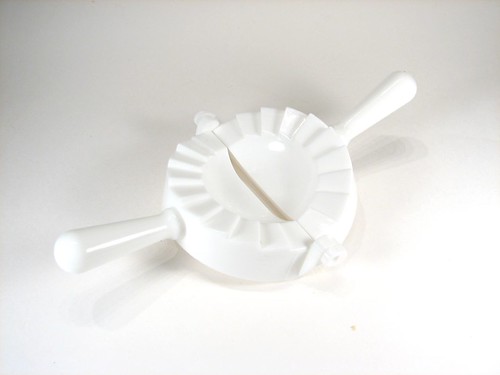 Gyoza presses, also called dumpling, potsticker, or dough presses, are readily available and can be found relatively cheaply. We found ours at Daiso, a Japanese dollar store chain.
Gyoza presses, also called dumpling, potsticker, or dough presses, are readily available and can be found relatively cheaply. We found ours at Daiso, a Japanese dollar store chain.
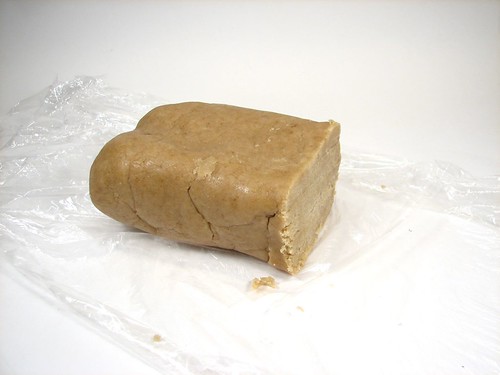 We used this recipe from Cupcake Project for eggless cookie dough for “raw” eating rather than baking. That’s a good idea because what we’re making here is not baked or fried, just simply cookie dough and ice cream.
You can also use your favorite recipe or even store bought dough (and make your own judgement call about eating raw dough that contains eggs).
Mix up the dough, roll it into a log, wrap in plastic and refrigerate until it is well chilled. Don’t add any chocolate chips or other crunchies that will add texture to your dough. You want it to be smooth for rolling out thinly.
We used this recipe from Cupcake Project for eggless cookie dough for “raw” eating rather than baking. That’s a good idea because what we’re making here is not baked or fried, just simply cookie dough and ice cream.
You can also use your favorite recipe or even store bought dough (and make your own judgement call about eating raw dough that contains eggs).
Mix up the dough, roll it into a log, wrap in plastic and refrigerate until it is well chilled. Don’t add any chocolate chips or other crunchies that will add texture to your dough. You want it to be smooth for rolling out thinly.
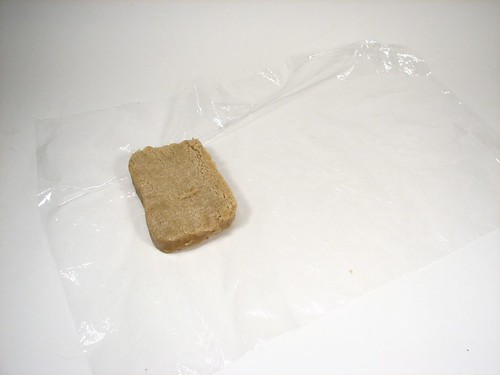 Cut a slice of dough off of the log onto a piece of plastic wrap.
Cut a slice of dough off of the log onto a piece of plastic wrap.
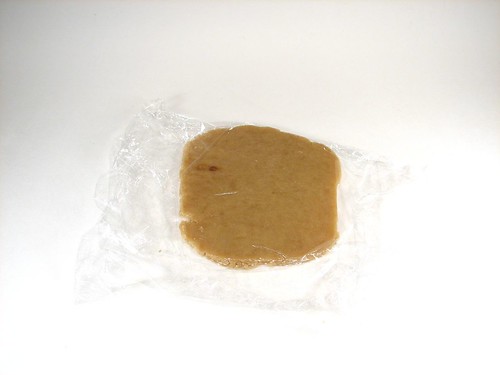 Fold the plastic wrap over the slice of dough and roll it out until it is a little larger than your gyoza press.
Fold the plastic wrap over the slice of dough and roll it out until it is a little larger than your gyoza press.
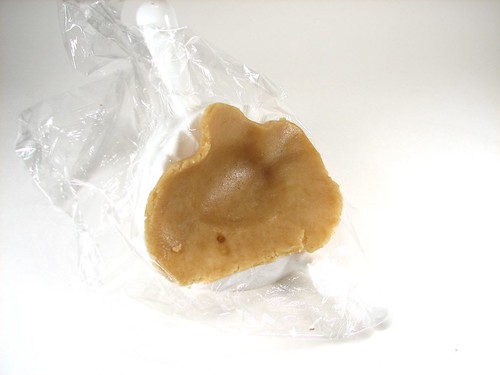 Peel the plastic wrap off of one half of the circle of dough. Lay the thin dough over the press and gently push it into the center to make a depression for the ice cream.
Peel the plastic wrap off of one half of the circle of dough. Lay the thin dough over the press and gently push it into the center to make a depression for the ice cream.
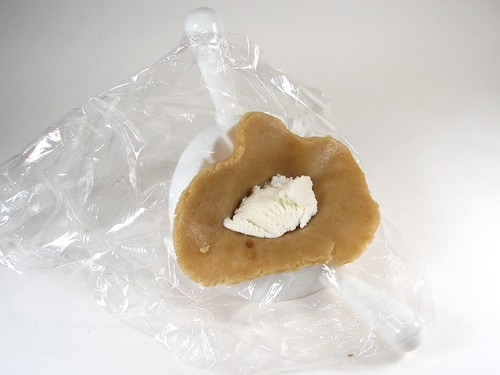 Put a small spoonful of ice cream into the depression.
Put a small spoonful of ice cream into the depression.
 Close the press carefully but firmly until the two sides are squeezed together. Carefully open the press, using the plastic wrap to pull the dough away from the press. The dough has a tendency to crack along the edges, but can be pressed back together.
Close the press carefully but firmly until the two sides are squeezed together. Carefully open the press, using the plastic wrap to pull the dough away from the press. The dough has a tendency to crack along the edges, but can be pressed back together.
 After you remove the gyoza from the press, trim any excess cookie dough off the edges with a knife. You can reuse the excess dough for more gyoza; just be sure to chill it again first. Put the finished gyoza in the freezer until you’re ready to serve. The frozen dough will insulate the ice cream and keep it from melting, and has a wonderful texture.
Once you’ve made one and have a feel for how thin the dough should be, you may want to roll out all of your remaining dough slices. Then you can fill them one after another, putting each one in the freezer as they’re completed.
After you remove the gyoza from the press, trim any excess cookie dough off the edges with a knife. You can reuse the excess dough for more gyoza; just be sure to chill it again first. Put the finished gyoza in the freezer until you’re ready to serve. The frozen dough will insulate the ice cream and keep it from melting, and has a wonderful texture.
Once you’ve made one and have a feel for how thin the dough should be, you may want to roll out all of your remaining dough slices. Then you can fill them one after another, putting each one in the freezer as they’re completed.
 Once they’re thoroughly frozen, serve with chocolate dipping sauce.
Once they’re thoroughly frozen, serve with chocolate dipping sauce.
Related stories: Edible Origami and Dessert Sushi.




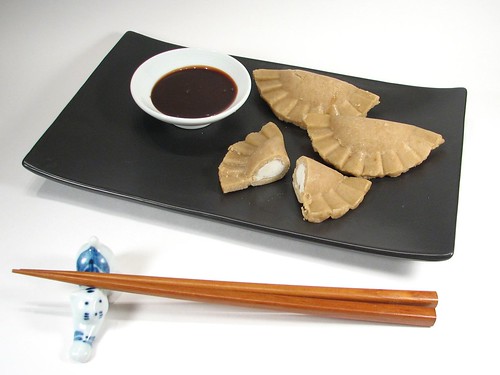
They make pasteurized in the shell eggs, or that pre-cracked eggs in a carton stuff that is safe to eat as raw food. I use it for whipped egg white stuff once in a while. Since this is an ice cream thing I doubt you’d be letting the raw sit out at room temperature for very long so thats not an issue.
I think this may be my weekend project with the kids ;) If you have the stuff you could probably flash fry these too and leave the ice cream in the middle cold… though I dont have the stuff to do that.
Only 1 in 30,000 eggs is at risk of salmonella. The real risk with raw eggs is when you handle *lots* of them and do not sterilize everything in between batches. If you handle 1000 eggs a day in a given piece of machinery and only sanitize once a day, this is a problem, as odds are approaching 1 in 30, or even less. Some companies making egg related recipes may handle way more than 1,000 eggs in a given day.
If you are only handling 2 eggs to make some cookie dough, your odds are 1 in 15,000 — making it slight less probable than bowling a 300 (1 in 11,500), 3 times the odds of a hole in one at golf (1 in 5,000), and more likely than injury from fireworks (1 in 19,000).
In fact, according to the statistics I pulled up in google, that would be the same odds as a random American speaking Cherokee.
Taking into account that salmonella really is not all that dangerous of a disease worrying about a few raw eggs is simple paranoia. Only 1 in 5 reported cases of salmonella ever even visits the hospital — and most cases are mild and never reported! Doctors estimate that there are 1.4 MILLION cases a year in the US — or about 1 in 200 people have trouble in a given year, and most didn’t even know it.
We are not claiming that this is a major hazard. (Ice cream is often made with raw eggs as well…) The only time that I think that it would even be a concern is if you’re eating pre-packaged but raw cookie dough– but a more important objection is that it doesn’t taste nearly as good. ;)
—
Windell H. Oskay
drwho(at)evilmadscientist.com
http://www.evilmadscientist.com/
Windell — sorry, that was more for JameS. Those more expensive eggs are really not worth it.
Raw eggs may not be a concern for you, but I would never them to my kids. But your creation looks extremely delicous and I think I’ll make some with pasteurized eggs.
My understanding is that the risk from salmonella isn’t from the raw egg contents but from contamination from the shell. If that is the case, simply wash the egg before handling it to include in your recipe.
No, never wash an egg!!
The water forces debris on the surface through the pores and into the egg. If you somehow get one with a stain on it, just throw it away. If you get them "farm fresh" with some debris on the surface, you can just wipe off the outside with a dry paper towel.
Never wash an egg, ever!
These are brilliant! Thanks, party people!
Hmm… this could work!
I wowed my best friends with Dry-Ice Martinis last time, and I need something to follow-up. I made the martinis more impressive by putting a diffused light under the coffee table, and darkening the room. The fog lit up like phosphorus smoke, and once the dry ice was all gone, it left a pretty chill martini. (one regret: I didn’t put a big enough chunk of DI in each glass to get to "insanely cold" because I didn’t want to wait that long to drink them.
Anyway, I’m going to try using my trusty propane torch to toast the outside just before serving. I’ll practice first, so I’ll email my results. Sometime late in the month, I’m afraid (sigh.)
My raw cookie dough recipe could not possibly have been put to better use. I am in love with your idea!!
hehe ,I’m Chinese ! ! It looks delicious, while we don’t make dumplings in this way.
That looks fantastic. My Japan-obsessed daughter would love it. I’m wondering if this could also be done with a cooked crepe, sealed at the edges with a light brushing of sugar solution. I’m going to start searching the nets now for a gyoza press in the UK.
Actually I found this in one of the super market in Chengdu. I think Chinese do use this to make dumplings..
Here in Japan I’ve had several varieties of desert gyouza. While not necessarily "common" the concept isn’t so rare. Do an image search for デザート 餃子 and you’ll see what I mean. I’ve personally had desert gyouza that had an apple filling and was fried, and a teppan fried variety that had Japanese pumpkin inside with a side of vanilla ice cream and a small saucer of chocolate sauce. Oh, and crepe style chocolate banana. If you’d like some recepes I could translate some for you.
Recipes would be great! Only to find them after you put them on here! I imagine you could used any prepared (canned) pie filling from the store in these too, to make it really simple.
hi~Im from China. I found it is very interesting that this design is actually not new back in China. Maybe four years ago, I found this tool in the super market. We use this for making dumpings.
I just want to say that there may be a lot more inspiring things in China. If you guys are interested, why not go and check it out? if you dont mind, im happy to be your tour guide.
These tools are absolutely not new– it’s quite common, actually.
Pictures from my trip to China are here.
—
Windell H. Oskay
drwho(at)evilmadscientist.com
http://www.evilmadscientist.com/
Could you use a shortbread dough? My favorite shortbread has NO eggs.It is really yummy and easy too.
1 Cup softened butter
1/4 Cup brown sugar
1/4 Cup powdered sugar
2 Cups Flour
Cream the butter and sugars then slowly add the flour.
Easy Peasy!
You could also just make vegan cookie dough…then you never have to worry about salmonella, and it tastes just the same if not better (though I’m biased) and is perfectly easy. Even when you’re baking your cookies, vegan dough means you don’t have to have any worry about eating some before it’s cooked. Just a thought…
There are plenty of reasons to eat vegetarian or vegan diets, but salmonella avoidance is not one of them. There are plenty of plant vectors for salmonella transmission. In any case, the milk and butter in the recipe we referenced are likely to be pasteurized or otherwise processed, making them fairly safe.